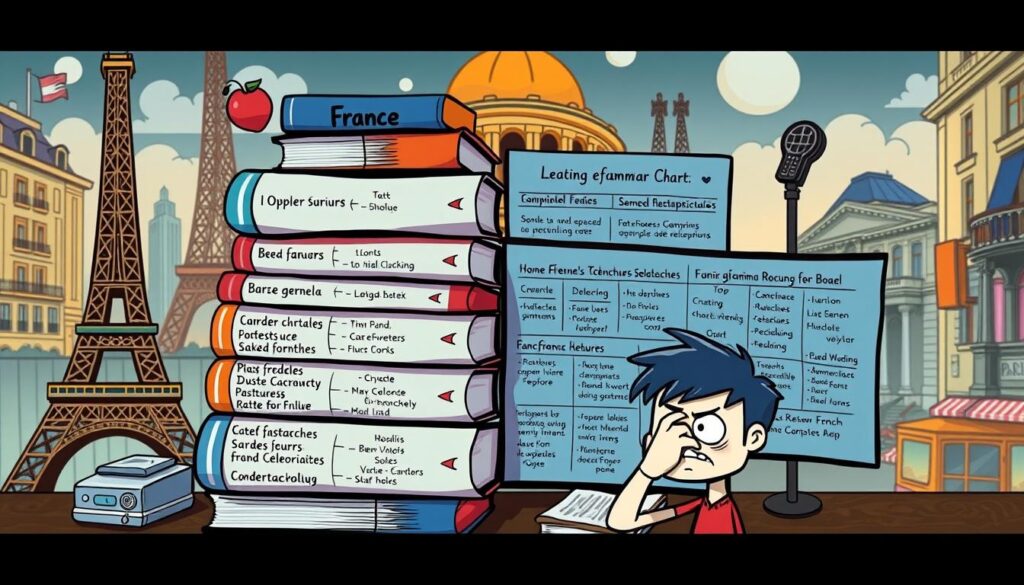When English speakers approach the French language, they often wonder, is it hard to learn French after English? With French as the official language in twenty-eight countries and boasting 230 million speakers, this romantic tongue is a gateway to a world infused with cultural depth and expressive richness. French language difficulty for English speakers is typically rated as “Easy” by the Foreign Service Institute and the European Language Center, suggesting that the path to fluency might not be as steep as one might initially think.
Considering that approximately thirty percent of English vocabulary has French origins, learners find a familiar landscape of words, making language learning challenges less formidable. In fact, it takes an average student about twenty-four weeks, around 600 hours, to reach general professional proficiency in French, indicating that the leap from English to French is within reach for those committed to their linguistic journey.
Despite the nuances of gendered nouns and the melody of French pronunciation with its silent letters, English and French share the same Latin alphabet and a penchant for subject-verb-object sentences, simplifying the narrative for English speakers. Therefore, the process of mastering French, while it may have its hurdles, is decidedly less daunting with the wealth of shared linguistic features and available resources.
Assimilating a new language invariably comes with its challenges. However, French stands out as not only one of the easier languages to learn for English speakers but also as a rewarding endeavor that unfolds the pages of global diplomacy, literature, and culinary arts. English speakers keen to venture into the world of French can look forward to a language that, while intricate in its gender rules and phonetics, offers a structured and consistent pronunciation system, further whittled down to manageable levels with the need for only a handful of tenses in regular discourse. Is it hard to learn French after English? Given the similarities and robust support structures, the answer leans toward an encouraging “non.”
Evaluating the French Language Difficulty for English Speakers
Learning French as an English speaker presents unique challenges and opportunities. The journey involves understanding complex language structure, mastering varying grammatical rules, and navigating significant pronunciation and vocabulary differences.
Assessing Language Structure and Grammar Challenges
French is known for its detailed grammar rules, which include gendered nouns and intricate verb conjugations. Native English speakers often struggle with these aspects as they require a deep understanding of how French sentences are constructed. Institutions like the School of Language Studies offer structured learning that categorizes French as a comparatively easy language for English speakers, requiring about 30 weeks to reach professional proficiency. However, Manfred Pienemann’s research indicates that grammatical structures must be acquired in a specific order, much like a child learning their first language, suggesting a natural progression in language learning irrespective of the learner’s native language.
Understanding Phonetics and Pronunciation Hurdles
The phonetic system of French includes sounds that are not present in English, such as nasal vowels and liquid consonants, which can substantially hinder correct pronunciation and fluency. The subtleties of French phonetics can be particularly daunting; therefore, methods suggested by findings in the language acquisition during sleep research, such as listening to language tapes at night, can complement traditional learning by reinforcing phonetic comprehension and retention.
Exploring Vocabulary and Cultural Differences
Cultural understanding is crucial when learning French as an English speaker. The nuances of vocabulary not only convey meanings but also include cultural connotations that are essential to master for effective communication. For instance, French immersion programs in Canada have shown that students can achieve near-native proficiency by Grade 12, which underscores the importance of cultural immersion in language learning. Despite this, students may still encounter difficulties with vocabulary nuances and idiomatic expressions, which are often intertwined with cultural context.
The process of overcoming these challenges involves both structured learning and immersive experiences. Here’s a comparative view of the effectiveness of different learning environments based on recent studies:
| Learning Environment | Benefits | Drawbacks |
|---|---|---|
| Traditional Classroom | Structured learning, explicit grammar teaching | Limited real-world practice |
| Immersion Programs | Rapid language acquisition, cultural integration | High initial learning curve, potential for academic pressure |
| Online Learning Platforms | Flexible scheduling, diverse resources | Lacks personal interaction, depends on user’s self-discipline |
Ultimately, while the French language presents several learning hurdles for English speakers, the right blend of educational methods and immersive experiences can significantly ease the learning process, making mastery a more attainable goal.
Is It Hard to Learn French After English?
Embarking on the journey of mastering French as a second language is often viewed with a mix of anticipation and apprehension. English speakers may wonder whether overcoming language barriers when learning French is inherently difficult. Fortunately, insights from linguistic research and learner experiences reveal that, while there are challenges, the prospects of learning French could be less daunting than anticipated.
French, categorized as a Category 1 language by the Foreign Service Institute, demonstrates its relative ease for English speakers due to shared Latin roots. This classification underlines how the structure and vocabulary of French have significant overlaps with English, which aids in faster learning. Despite this, certain facets of French like pronunciation, gendered nouns, and verb conjugations do impose language learning challenges.
Challenges specific to French, including the notorious nasals and the guttural R, often intimidate learners. However, these pronunciation challenges don’t involve the tonal complexities that you might encounter in languages like Mandarin, making them more manageable with persistent practice. Additionally, French uses the same Latin alphabet as English, which simplifies reading and writing efforts from the start.
One of the notable hurdles is the grammatical structure, such as gender agreement and verb conjugations that can seem labyrinthine at times. To navigate through this, consistent practice and exposure to the are crucial. French’s extensive use of gender-specific nouns and complex conjugation rules can be contrasted with English in a structured learning environment, promoting better understanding and retention.
Moreover, English speakers will find an ally in the substantial vocabulary shared between English and French, easing the transition and making mastery seem less like an insurmountable task. Similar to romance languages, French features numerous cognates and borrowed vocabulary which align closely with English, further smoothing the learning curve.
Despite these complexities, effective strategies tailored to individual learning preferences are vital. Engaging with French culture, utilizing language learning tools, and interacting with native speakers are part of successful strategies for overcoming language barriers. As learners increase their exposure to French, the language intricacies begin to unfurl, transforming challenges into stepping stones towards fluency.
In summary, while French poses certain language learning challenges, English speakers have a foundational advantage due to linguistic similarities. The fear associated with learning a new language often subsides as familiarity grows, leaving room for both linguistic and cultural appreciation. Therefore, the difficulty of learning French can vary substantially, but with the right approaches, the barriers to mastering French as a second language can certainly be overcome.
The Journey to Mastering French as a Second Language
The conquest of becoming fluent in French is uniquely challenging and rewarding, illustrated well by the experiences of learners who chart their progress meticulously. Understanding the nuances and overcoming the barriers of this rich language hinges significantly on personal attitude and the strategic employment of various learning resources. The best way to study French not only involves traditional learning methods but also incorporates modern technological aids and social interactions.
The Influence of Attitude and Dedication on Language Learning
A learner’s journey from the basics of French to advanced comprehension can be quite dynamic. As an example, consider a dedicated learner who started with minimal French and, over the course of approximately 13 months, passed the challenging DELF B2 exam. This sheer dedication led to impressive personal achievements such as the ability to engage in conversations easily, understand diverse French media, and even dream in French. The key takeaway? A steadfast commitment and a positive outlook significantly bolster the language acquisition process.
Resources and Communities: A Support System for Learners
The realm of French learning is vastly enriched by the variety of resources available to learners. Among these, language learning apps like Duolingo and Anki provide structured linguistic practices, facilitating the rapid acquisition of vocabulary and grammatical rules. Immersive experiences such as the Italki Challenge, where learners engage in 20 hours of conversational practice, and feedback-driven platforms like Italki Notebooks offer crucial real-time language usage and correction, rendering them invaluable for learners.
Fostering immersion in the French language can also be achieved without relocating to France. From listening to podcasts like InnerFrench to engaging in language exchange with native speakers, learners can create an immersive learning environment that mimics the natural language acquisition settings. Community support plays a pivotal role in this journey, transforming the daunting task of mastering French into a collaborative and interactive pursuit.
| Learning Milestone | Date Achieved | Resources Used |
|---|---|---|
| Completed A2.1 Lingoda Challenge | Mid 2019 | Lingoda, Duolingo |
| Consistent use of Anki for Vocabulary | June – September 2019 | Anki app |
| Passed DELF B2 Exam | December 2019 | DELF Prep, Private Tutoring, Italki |
Ultimately, embracing every aspect of learning French, from the frustrating to the triumphant, furnishes learners with both the skill and the confidence to use French fluently. The combination of personal dedication, effective use of diverse learning resources, and immersion techniques culminate in a deeply rewarding journey towards mastering French as a second language.
Unveiling the French Grammar Similarities with English
At the heart of language lies structure, and a fascinating aspect of French and English is their shared linguistic heritage. Intriguingly, linguists have found that up to 45% of terms in both languages overlap, with as many as 27% of words exhibiting lexical kinship both in form and meaning. This closeness in vocabulary is a testament to their mutual lineage, with more than 1,700 true cognates reinforcing this bond. While examining the french grammar similarities with english, one cannot overlook that these two tongues emanate from the same ancient linguistic family, passing down the legacy of Latin influence and echoing the profound global influence of French and English.
Tracing the Common Origins and Latin Influence
Both English and French celebrate a storied history of interaction, where the latter’s elegance graced the courts of England, leaving a trove of loanwords in its wake. Historical records reflect this constant exchange, demonstrating a shared common origin rooted deeply in Proto-Indo-European foundations. The establishment of institutions like the Académie française sculpted the French language into a beacon of eloquence, imposing an aristocratic veneer on the tongue that traversed international borders. Such entities aimed to purify and standardize French, with the ripple effect of such linguistic purity sometimes creating barriers to public speaking due to the expected conformity to high language standards—quite different from the trajectory of English, dubbed the “language of the people.”
Analyzing Cognates and Shared Sentence Structures
The grammatical frameworks of French and English provide fascinating parallels for language learners. The clear presence of shared sentence structures—principally the subject-predicate-object syntax—is encountered in both languages, simplifying comprehension for those mastering French after English. Notably, syntactic similarities extend to the usage of auxiliary verbs, participles, and tense constructions, architecting a familiar landscape for English speakers. With structured learning materials, such as those outlined at LanguageYard, English speakers can efficiently acquire French by engaging with resources that highlight these linguistic consonances. Moreover, while French articulates gender through its nouns and English through its pronouns, the underlying structure encourages interlingual cognizance that accelerates learning and fluency, showcasing how the cognates and shared heritage underpin a synergy between these two global languages.


